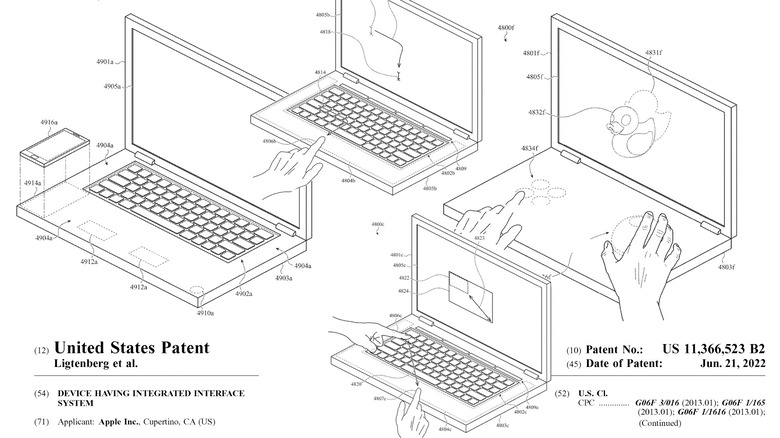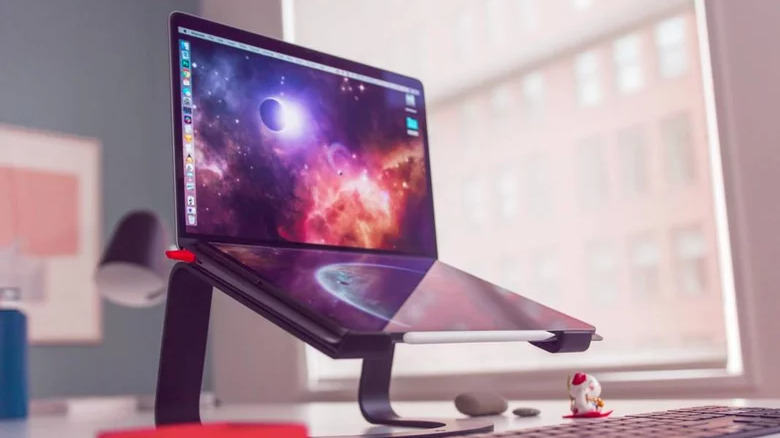Apple Hasn't Given Up On This Futuristic Device Concept
This week the U.S. Patent and Trademark Office (USPTO) revealed a patent application for a futuristic MacBook with touchpad keys and a configurable touch panel with 3D touch support surrounding the keyboard. Apple first applied for this specific iteration of the patent in 2020 but has been working on iterations of the concept for several years.
For those looking to buy a multi-screen laptop already out on the market today, there are plenty of options. Most of them do not aim to match the absurdity of the seven-screen laptop – a concept from the now-defunct brand Expanscape. Branch such as ASUS, Lenovo, and HP are actively invested in the segment and pumping out commercial products — mind you, not prototypes, but products — with two or more screens, often with touch and stylus input support.
Although the market has a handful of choices for Windows users, Apple fans have been relatively harder to convince about the utility of a touch interface, leading to controversial takes on the touch bar, and making a touchscreen MacBook a distant dream. While the fate of a touchscreen MacBook reaching the market is iffy, Apple's mysterious and forward-looking MacBook has been in the works for several years, and the recently granted patent is in continuation of a previous patent for a configuration device filed in 2018 and awarded in 2021.
Apple keeps drawing and gesturing
The recently granted patent describes critical aspects of Apple's vision for the concept device. It shows portions of glass surrounding the keyboard. As per the application, these areas serve as touch-sensitive means of input with utility that can be set up based on the application running on the MacBook. The touch area evidently replaces the trackpad and could support 3D force touch with haptic feedback. The patent suggests that this concept could automatically adapt to the usual force applied by the user when the user rests their palms on the device's base to prevent false touches.
This same touch sensing area (between the keyboard and the user) could also be used for biometric authentication using a person's palm prints, as represented in one of the images created by Apple for the patent. Alongside the top case, Apple also suggests in the patent application that the sides of the device could feature touch-sensitive portions for programmable touch input.
One of the most appealing aspects of this patent is the keyboard, which also acts as a touch-sensitive surface. Apple presents two different scenarios in which this could happen. First, the purported MacBook could either use a virtual keyboard with keys appearing only when a user is required to type or act as a configurable secondary screen with controls changing with the application running on the MacBook. Brands such as Lenovo have already demonstrated something like this several years ago.
It's still just a dream
Alternatively, Apple proposes the device could feature a keyboard with actual mechanical keys with touch-sensitive surfaces on top. Based on the intensity with which a user touches a key, the computer will be able to distinguish between a touch or a key press. The patent shows how the notebook's entire lower half could be used as a single large touchpad, ignoring the keys of the keyboard when activated.
The patent also indicates a portion of the palm rest could be used to charge an iPhone — or any other compatible device — wirelessly. It could be even more interesting if the MacBook launches a special mode similar to Samsung's DeX when the iPhone is lodged into this slot.
It is essential to note that companies often apply for patents just to be able to reserve exclusive rights to an idea, and these ideas may never see the light of the day. Nonetheless, Apple's concept suggests features we may see in MacBook and iPad devices some years down the line — as soon as Apple can finally succeed in convincing users to adopt secondary touch interfaces other than the display, beyond the touchpad.


